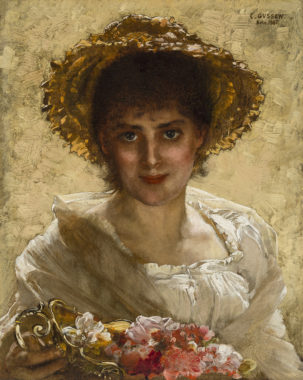Gussow, Carl
Sold Artworks
Biography
Carl Gussow
1843 Havelberg – 1907 Munich
At the age of only twenty-seven Carl Gussow was named a professor at the Weimar School of Art. This appointment was to lay the foundation for his future career. He rapidly earned a reputation as a charismatic and insightful teacher. His technical virtuosity was widely acclaimed. In 1874, he moved to the Karlsruhe School of Art, where Max Klinger was to be his pupil. Two years later, Anton von Werner, the Director of the Berlin Academy of Fine Arts, called Gussow to Berlin to lead the class in portrait painting at the Academy. His teacher’s move prompted Klinger to leave Karlsruhe for Berlin, where Gussow and his protégé were to form a lifelong friendship based on mutual appreciation and esteem.
Berlin, the thriving capital of the German Empire, provided Gussow with the perfect environment for a stellar career. When the number of applicants for a place at the Academy of Fine Arts began to outstrip the number of available student places, he set up his own private painting school. This turned out to be a lucrative enterprise that brought him a healthy income. His reputation soon spread far beyond Academy circles. The photorealistic qualities of his work were in such demand that he advanced to be one of Germany’s most successful naturalist painters. His anecdotal genre scenes enjoyed outstanding success at exhibitions in Belgium, France and England, while the domestic market eagerly snapped up his portraits. High society lauded his talented representation of female elegance and the bold self-confidence of his male sitters. Illustrious individuals such as the industrialist Werner von Siemens, the economist Julius Wolf and the architect of the Reichstag building, Paul Wallot, were among his patrons.
In his striving to achieve the highest degree of realism Gussow developed a distinctive painting technique. This involved the use of transparent glazes placed in juxtaposition to areas of impasto. His style is notable for its striking colouristic contrasts, love of modelling and delight in the interplay of light and shadow. His perfectionist approach is reflected in his use of pigments and varnishes which he mixed himself. He even developed and patented a brush with extremely short bristles which still bears his name – the Gussow Pinsel. It allows the painter to work with maximum precision when applying and distributing paints on the picture surface.
Despite his resounding successes in Berlin, personal reasons led Gussow to leave Berlin in 1892 and start a new life in Munich. In the same year, members of a younger generation of artists founded the Munich Secession – an association which would pave the way for Modernism. By then Naturalism had reached its zenith. Overshadowed by its decline, Gussow was unable to replicate the earlier successes of the Berlin years. His oeuvre was largely forgotten on his death in 1907 – even though the Royal Academy of Arts honoured him with a commemorative exhibition. But his former pupil and friend Klinger, by then basking in a Europe-wide reputation as Germany’s leading exponent of Symbolism, kept the memory of his work alive. When asked to name the most important German artists of recent times, he mentioned Gussow in the same breath as Wilhelm Trübner, Franz Stuck and Max Slevogt.
PDF Download